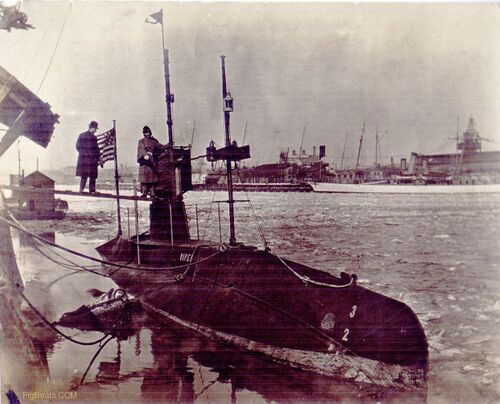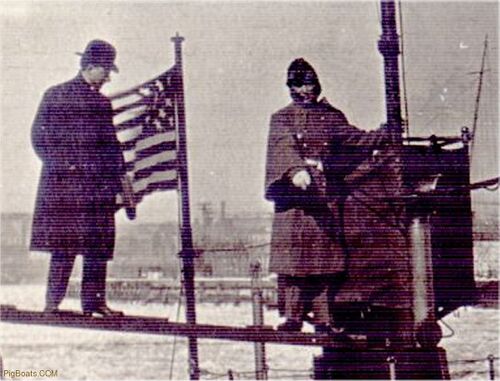B-1

We think that the photo was taken at or near the Brooklyn (New York) Navy Yard just prior to a dry dock period that all three B-boats had in January, 1908. If it was after dry docking the waterline would appear cleaner and crisper.
The submarine has the paint scheme given to the vessels around the time of their commissioning with darker colors, (black), and a light, (white), boot-top. On the foremast are the submarine's red and green running lights attached to their reflector boards. These boards are to limit the direction that the lights can be seen from. Above them, the anchor light is higher on the mast. This is a white light and used when at anchor to note it position to other vessels. All these lights and the mast are portable and are removed and sent below when the submarine is going to dive. Stanchions and a lifeline surround the small walking deck that submarine inventor John Holland so detested, ("...for officers to strut on...", he said). These, too, were sent below when diving.
Photo in the private collection of Ric Hedman

The top of the bridge is surrounded by weather canvas to protect the crew, (duty officer and helmsman), from spray and wind. Just forward of the canvas is a ventilator used to bring or exhaust air from inside the submarine. Its opening is pointing to the sub's port side. These, along with all the above mentioned items, are also sent below before diving. Pressure of moving though the water would restrict the vessels movements, reduce its speed and probably destroy canvases.
There appears to be a fairly stiff wind blowing by the looks of all the flags and that wind seems to be coming from the subs after port quarter. The flag is a thirteen-star Naval Ensign. As related by flag historian Jeff Bridgman..."It wasn't until 1916, however, that President Woodrow Wilson wrote an executive order that terminated their use entirely in favor of 48-star flags. But even this did not completely put an end to it. According to at least one flag historian, Wilson's order was not immediately accepted on all navy ships. Old habits die hard..." The flag being flown seems to be of an older design that was flown between 1890 and 1900 with the rows of 3 stars with points pointing up and the rows with two stars with the points pointing down. The wind chill factor must make the temperatures must feel like they are in the upper 20's down into the teens or lower.
National Archives photo

National Archives photo
Page created by:
Ric Hedman & David Johnston
1999 - 2023 - PigBoats.COM©
Mountlake Terrace, WA, Norfolk, VA
webmaster at pigboats dot com
